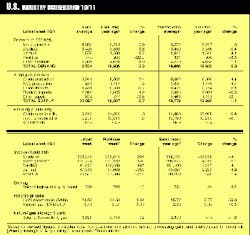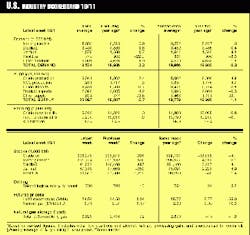OGJ Newsletter
The elation that followed the September OPEC meeting-a result of OPEC's assurances that oil markets would not soon be laden with excess supplies-was short-lived.
As OGJ went to press, oil prices were continuing a decline that had lasted more than 3 days. In London trading on Oct. 6, Brent for November delivery closed at $22.76, down 17¢/bbl on the day and a fall of 91¢/bbl from the Oct. 1 closing price. NYMEX crude was trading at $22.68/bbl at mid-morning Oct. 7, a 15¢ decline from the opening price and down $1.86 from Friday's close.
The price decline was linked, at least in part, to the Oct. 4 passage of a UN resolution increasing the dollar value of Iraq's allowable oil exports under the current stage of the oil-for-aid agreement.
The resolution allows Iraq to sell an additional $3.04 billion worth of oil during Phase VI of the program, which encompasses May 25-Nov. 21. This brings potential revenues for the phase to a total of about $7 billion. By early October, Iraq had sold $4.87 billion worth of crude during Phase VI.
The rebound in oil prices since early 1999 has been enough to prompt some Canadian heavy oil producers to boost spending, says the Canadian Energy Research Institute. "With the price of Bow River crude up by 39% from January and light-heavy differentials (Edmonton Light vs. Bow River) down to $2.80 (US) as of June (from $4.50 a year ago), the Canadian heavy oil industry is slowly recovering," said CERI.
Among the producers bolstering their budgets are: PanCanadian, increasing upstream funding by 20% to $515 million (Can.); Crestar, boosting heavy oil spending by 100% to $135 million; and Poco Petroleum, raising yearly spending to $255 million from $185 million.
The upstream sector's recovery this year has yet to trickle downstream to refiner-marketers, or to the oil field service-supply sector.
Asian refining margins are not expected to improve in the upcoming months, despite recent crude oil price gains, says Singapore Petroleum Co. Difficult market conditions have lingered, says SPC, due to a glut in Asian refining capacity and petroleum products supply. And this year's increase in oil prices is not of sufficient duration yet to allow product prices to adjust fully. SPC has shown a $2.88 million net profit for the first half of this year, it said, noting a slight recovery in Asian economies and some increases in product demand.
According to the latest annual rig census conducted by Reed-Hycalog, US rig activity fell to a 47-year low this summer, with only 860 units working over a 45-day period. Total available rigs dropped by 61 to 1,644 in the 1999 census, ending a 2-year streak of gains (OGJ, Oct. 5, 1998, p. 36). As industry consolidation continues, the number of contractors declined to 219, down 21 from last year. Fifteen firms now own 54% of all US-based rigs.
The ever-changing landscape of Germany's energy sector is attracting the attention of US-based Southern Co. The firm announced it is considering taking a stake in power utility Veag, local reports said. In addition to possibly obtaining equity in the Berlin-based utility, Southern Co. may be looking to increase its stake in Bewag, another Berlin utility.
Marcie Fuller, a Southern Co. board member and chief executive of the group's international investments arm, told German daily Handelsblatt that her firm is looking at a wide range of possibilities. Its options are contingent on the soon-to-be-merged German firms Veba and Viag (see story, p. 36) either selling or lowering ownership percentages in Veag and Bewag.
The wolf has loped away from the door of London independent Premier Oil on hearing the news that the company clinched a funding deal with current interest holder Amerada Hess and Malaysia's Petronas (OGJ, Oct. 4, 1999, Newsletter). Petronas acquired newly issued Premier shares amounting to £101.2 million at 25 pence/share, giving it a stake of 25% in the company. Amerada meanwhile bought £34.8 million worth of new equity to maintain a 25% stake in Premier.
Premier CEO Charles Jamieson said, "The alliance will not only allow us to continue the development of our existing portfolio but also position us as the leading Asia independent." Petronas sees the enlarged Premier as a "primary investment vehicle" in the region, while Amerada said the deal "significantly enhanced the investment proposition" through material growth opportunities.
The offshore West Africa play became hotter than ever on the news that Triton Energy had made a major oil find on Block G off Equatorial Guinea. On test, the Mbini-1 well, which was drilled to 9,700 ft TD in about 2,200 ft of water, flowed 12,401 b/d of 30° gravity oil with 897 psi flowing tubing pressure from a 160-ft interval in a single zone. The well is about 22 miles off the coast and 200 miles southeast of Zafiro oil and gas field; it lies 125 miles south-southwest of undeveloped discoveries off southern Cameroon.
The new field, dubbed La Ceiba, is the first discovery in the Rio Muni basin. Operator Triton said preliminary test data indicate a potential production rate of more than 20,000 b/d upon completion of the well. Interests in Block G are Triton, 85%, and Petronas's majority-held Energy Africa Ltd., 15%.
"The Mbini-1 discovery proves the existence of a working hydrocarbon system in the previously underexplored Rio Muni basin and opens up what may prove to be a very significant offshore West African hydrocarbon fairway," said Triton Pres. and CEO James C. Musselman.
The Association of Southeast Asian Nations has revealed plans for an integrated energy program for its 10 member countries. The scheme is aimed at benefiting from the 300 tcf of natural gas reserves in the region, say top ASEAN officials. The program will comprise two key projects: the Trans-ASEAN Gas Pipeline (TAGP) and the ASEAN Power Grid (APG).
In Kuala Lumpur last week at the first forum on TAGP and APG, Malaysian Energy Minister Leo Moggie emphasized the need for such a massive infrastructure project to support future economic growth in the region. He has set a completion deadline of 2010 for TAGP and APG, which have been under discussion since the mid-1980s.
The ASEAN council on petroleum and the heads of ASEAN power utilities and authorities have been charged with overseeing TAGP and APG. Plans for the projects will involve the interlinking of pipelines and transmission lines across the borders of the member countries. It will involve adding 7,000 km of gas pipeline, costing $10-15 billion, plus $90 billion worth of power generation, transmission, and distribution networks.
Most of the region's energy markets are underdeveloped, but their potential offers myriad investment opportunities. Those opportunities will be available to international energy companies as well as regional firms, as the region lacks the necessary funds to tackle a major infrastructure development project.
Jorge Chamot, president of Peru's state committee overseeing the Camisea natural gas project, has been named minister of energy and mines effective Oct. 1. He will replace Daniel Hokama, who recently tendered his resignation (OGJ, Oct. 4, 1999, Newsletter).
Industry sources see Chamot's appointment as confirmation that President Fujimori intends to press ahead as planned with the Camisea project before the general elections in April 2000. They also hope the government might reconsider some of the main points in the draft contract to which potential bidders object, such as regulated gas tariffs (OGJ, Sept. 27, 1999, p. 30). Hokama was reportedly adamant on fashioning the regulation of gas sales after the energy commission's regulation scheme for electricity sales, although it was not clear whether other members of the Camisea committee were in agreement.
Gustavo Caillaux, president of Copri, the government's privatization commission, said that a new Camisea president will be appointed after the committee's next meeting, which was scheduled for Oct. 5.
The health and environment subcommittee of the US House Commerce Committee's has approved a bill allowing California a waiver on use of methyl tertiary butyl ether in gasoline. The bill would allow California to skirt the federal oxygenate requirement if the replacement gasoline meets the Clean Air Act's required toxic emissions reductions and achieves the same cuts in auto emissions.
The congressional Alcohol Fuels Caucus opposed the bill, arguing the surplus MTBE would be used in other states, displacing ethanol that could be used to meet gasoline oxygenate requirements. EPA also opposes the measure.

